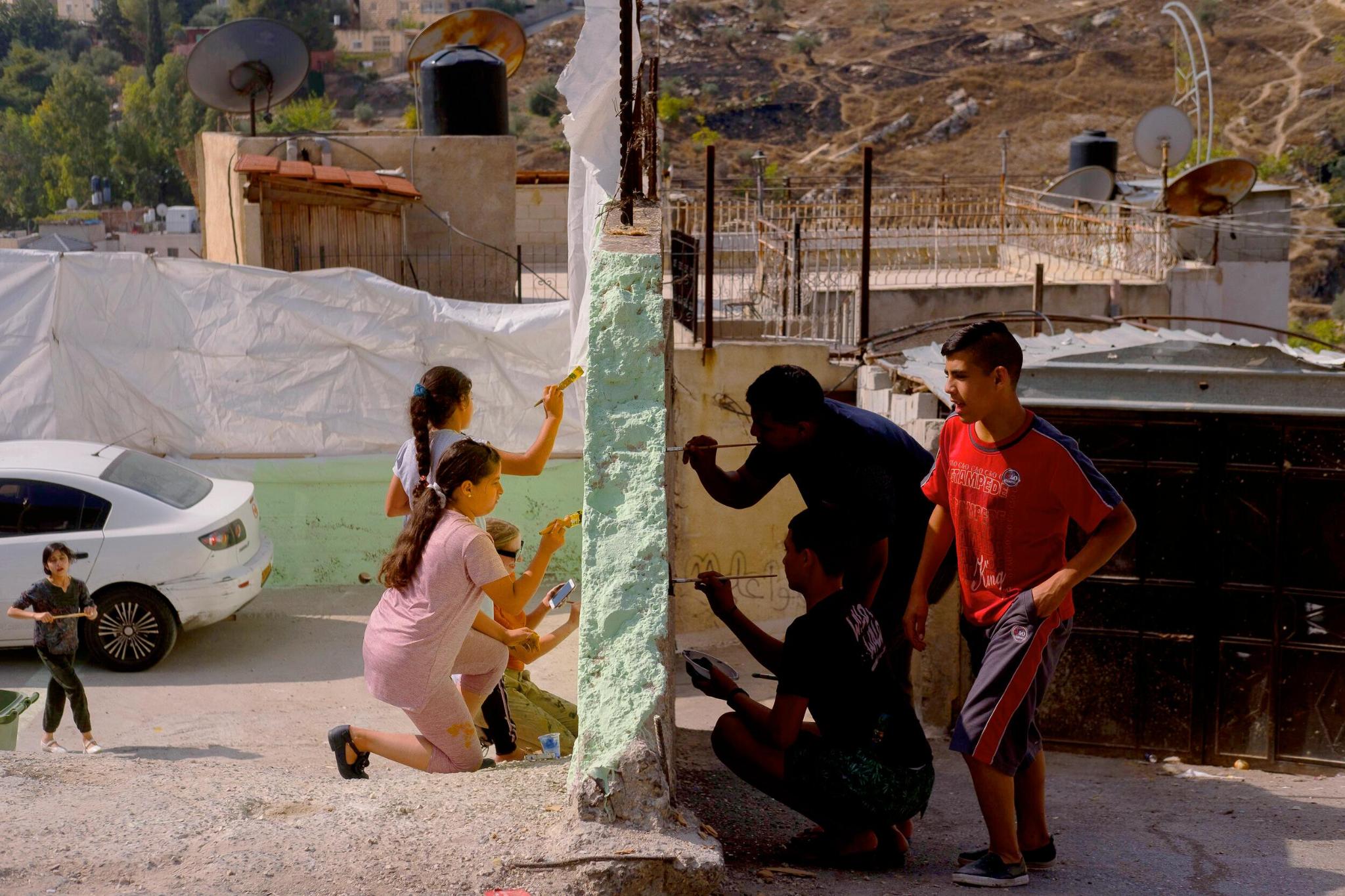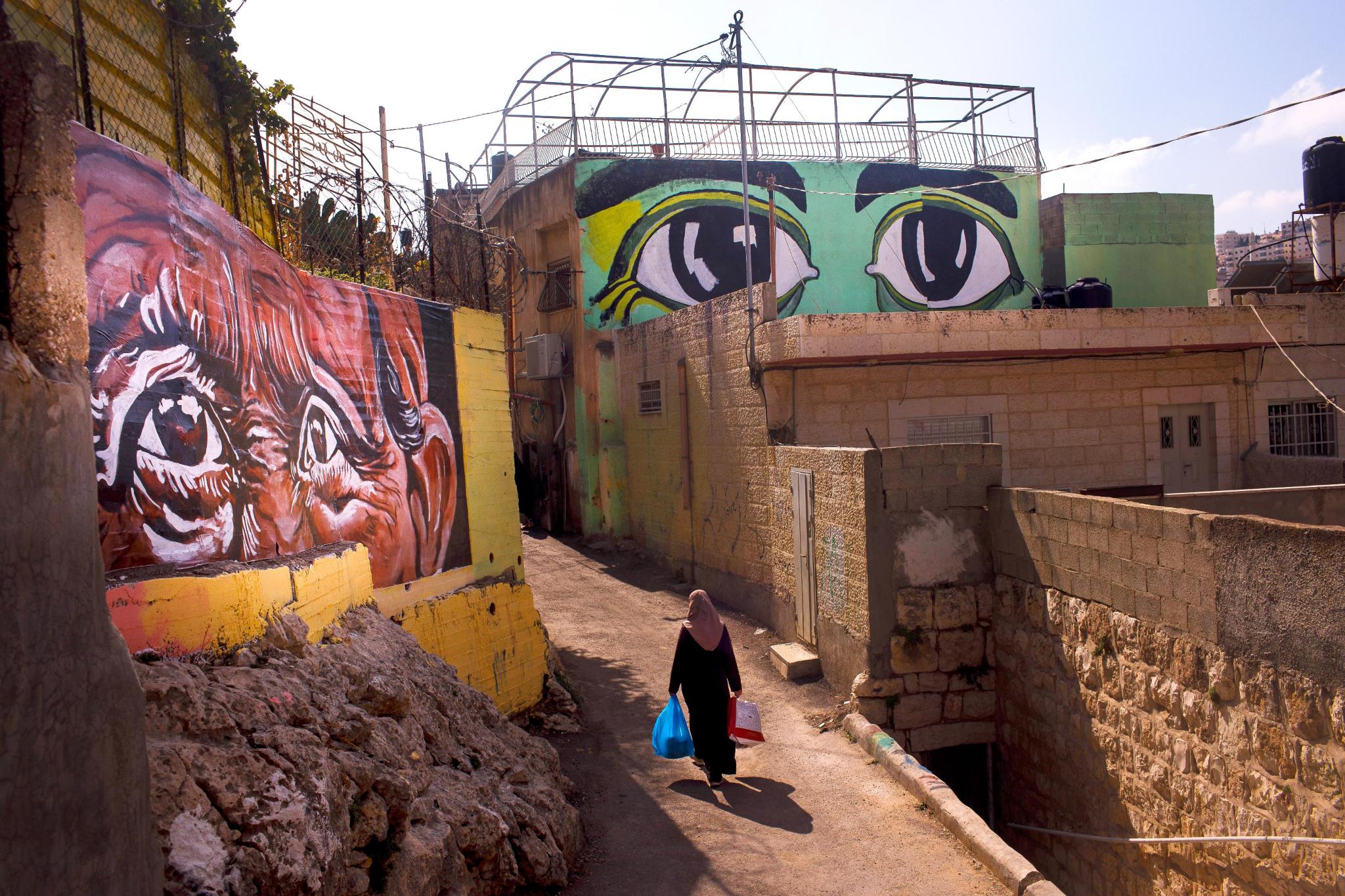New York War Crimes: What is I Witness Silwan?
I Witness Silwan: We are a community-based public art project rooted in Silwan, Occupied Jerusalem. Our project has involved hundreds of local artists and community members of every age, joined by artists and activists from around the world.
We paint murals on Palestinian homes targeted for forced displacement and demolition by the Israeli government and Zionist settlers. The murals give us joy and assert our ownership over our homes and agency over our futures. We turn walls into voices and streets into stories that passersby must reckon with.
We conduct bilingual tours to share Silwan’s real history and provide an alternative to the settler tourist industry, which caters to Christian Zionists and uses “heritage tourism” to justify the ethnic cleansing of Palestinians. We also run community-based youth programs, create social media content, film videos and documentaries, sell merchandise in our online shop to support the project, and more.
What are some of the common motifs that show up across I Witness Silwan’s murals? How would you describe these murals to someone who hasn’t seen them before?
The most publicly visible murals in Silwan depict 23 pairs of eyes of local and international leaders, martyrs, activists, workers, and more — all of whom keep watch over us Silwan residents as we resist the daily violence of Israeli occupation and ethnic cleansing.
People whose eyes are featured on the walls of Silwan include Ghassan Kanafani, George Floyd, Che Guevara, Bai Bibiyon, Malcolm X, and Rachel Corrie, as well as Palestinian farmers, and freedom fighters from the Silwan community.
Other mural imagery includes Palestinian liberation symbols (poppies, birds, hands flashing the victory sign), portraits of neighborhood children and elders, Al Aqsa Mosque, and quotes from significant Palestinian figures (poet Mahmoud Darwish, poet Fadwa Tuqan, martyred activist Nizar Banat, graphic artist Naji Al Ali, and martyred journalist Shireen Abu Akleh).
What are the conditions in Silwan right now and how have they changed since October 7? What are the forces responsible for or complicit in these conditions?
In Silwan, 55,000 Palestinians are resisting the daily violence of occupation and forced expulsion. Israel’s ethnic cleansing and destruction of Silwan is part of a wider effort to force all Palestinians out of Jerusalem.
Though the level of militarization and rate of ethnic cleansing has dramatically escalated since October 7th, Zionist colonization of Silwan has been underway since 1967, when Israel declared Jerusalem as its capital. Armed Israeli soldiers and settlers roam the streets and shoot, arrest, or otherwise abuse Palestinians, especially children and community leaders like I Witness Silwan’s co-director Zuheir al Rajabi. The I Witness Silwan team often paints murals while surrounded by guns and threats of murder.
There are several specific forces behind the ethnic cleansing of Silwan that we are trying to target:
-
The Israeli tourism industry renamed Silwan the “City of David” in 1967. The “City of David” is an ever-expanding biblical theme park that entertains over 1 million tourists annually with Zionist fantasies based on false archeology. The “City of David” includes tunnels underneath Silwan that whisk tourists from one spot to another and compromise the structural integrity of the Palestinian homes above. The propaganda spread by the park attempts to erase Palestinians’ deep historical roots in Silwan, making the struggle to document our history imperative.
-
U.S.-based Christian Zionists, who comprise the majority of visitors to “City of David”, believe that biblical prophecy requires Jews to colonize “the holy land,” expel non-Jews, and destroy Muslim holy sites to bring about the second coming of Jesus and the apocalypse. Prominent Christian Zionist politicians like Trump’s U.S. ambassador to Israel, Mike Huckabee, have financial ties to the settler industry.
-
Settler “non-profit” organizations like Ateret Cohanim and El-Ad, backed by the Israeli state and military, spearhead violent expulsions and court cases that rubber-stamp fabricated purchases of land to displace Palestinians. These organizations get much of their funding from U.S.-based counterparts that funnel tax-exempt money from American donors to Israeli settlements.
-
International companies like Korea-based HD Hyundai sell the construction equipment and industrial vehicles that Israel uses to demolish Palestinian homes.

We often talk about how the Palestine movement’s cultural front must highlight contradictions in the Zionist-complicit art world as well as elevate the work of Palestinian artists. How do you see I Witness Silwan’s work as being part of that cultural front?
Art and culture are essential tools for political education. Visual art, in particular, transcends language and literacy. It can convey ideas and reflect experiences more effectively than words. We’ve seen this in Silwan, where international visitors find their way to the neighborhood after seeing the giant murals of eyes on the hillside. Often, they arrive knowing nothing about Israeli occupation or ethnic cleansing in Jerusalem and then leave with knowledge and appreciation of Palestinians’ struggles and resistance here.
Political public art communicates powerful messages in widely accessible spaces that are often sites of contested power, like the streets of occupied Jerusalem. Creating public art in these contested spaces allows us to assert community ownership over them.
Collaborative murals create a broader shared culture and a sense of belonging and empowerment. We see this especially with children in Silwan. Their participation gives them back a piece of their stolen childhoods and encourages hope and action for a better future.
The relationships and shared culture that collaborative mural projects build serve other organizing contexts: We channel them to mobilize people for actions and campaigns. These are the gifts we hope to spread to organizers around the world.
How do you see I Witness Silwan’s work as being part of the broader struggle for a free Palestine?
Like all Palestinians, the residents of Silwan are defenders and protectors of our homes and homelands. We are fighting for our right to remain in the places where we live and have lived, in some cases, like that of the Siyam family, for up to 900 years.
Palestinians are fighting one struggle against Israeli ethnic cleansing, even though its specific mechanisms may vary by region. The forces behind the ethnic cleansing that I Witness Silwan exist across all of Palestine. As the Gazan artist Ayman Alhossary said when he contributed a mural, “We are one body, from Jerusalem to Gaza.”
What is your vision for the immediate and long-term future of I Witness Silwan, both in Jerusalem and around the world?
I Witness Silwan has always been an international project that uses technology to bring artists and their work to Silwan and connect struggles across borders.
I Witness Silwan has always been an international project that uses technology to bring artists and their work to Silwan and connect struggles across borders.
We are bringing our murals to the rest of the world, whether they are painted, wheatpasted, projected onto a wall, dropped as a banner, or posted on social media. We envision art in the streets, public spaces, protests, college campuses, places of worship, museums, cultural spaces, companies, and institutions complicit in Israeli ethnic cleansing. We are aiming for the murals of Silwan to become a recognizable visual language that the Palestine movement and other movements for justice can use wherever strategic.
We want to instill curiosity about, conviction in, and connection to Palestinians’ freedom struggle. We want to drive the world to “look Palestinians in the eye[s],” to use writer Mohammed El-Kurd’s phrase.
How can U.S.-based organizers and culture workers get involved and support I Witness Silwan’s work?
Artists and culture workers can join our international cultural intervention by reproducing and circulating I Witness Silwan’s murals and by creating original artwork that critiques the forces behind ethnic cleansing in Jerusalem. They can use and share this art for actions, art-based interventions in public spaces, community mural projects, social media, and more.
Possible actions include banner drops, projections, or postering at institutions complicit in Israeli ethnic cleansing; art-oriented disruptions of Christian Zionist events, Israeli tourism expos, settler organization fundraisers, etc.; mural-painting, wheatpasting and graffitiing in high-traffic public spaces; and more. Organizers can also get involved with existing campaigns like Not on Our Dime or the recently launched Home Destroyer HD Hyundai.
Please connect with us by emailing iwitnesssilwan@proton.me if you are interested in getting involved and have any questions. Follow I Witness Silwan on Instagram (@iwitness_silwan) or check out our website (iwitnesssilwan.org) for more updates on how to get involved as this campaign progresses.
I Witness Silwan is an international public art project in support of Silwan’s longstanding fight against dispossession. This interview appears in the sixteenth issue of The New York War Crimes.


